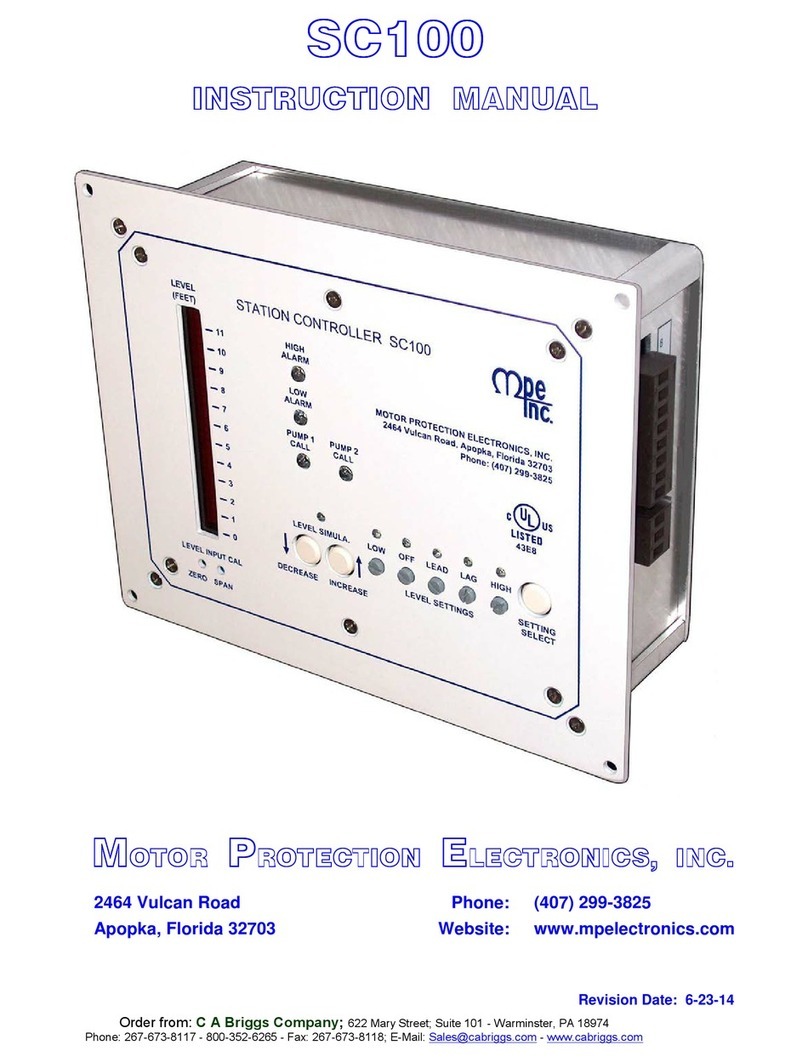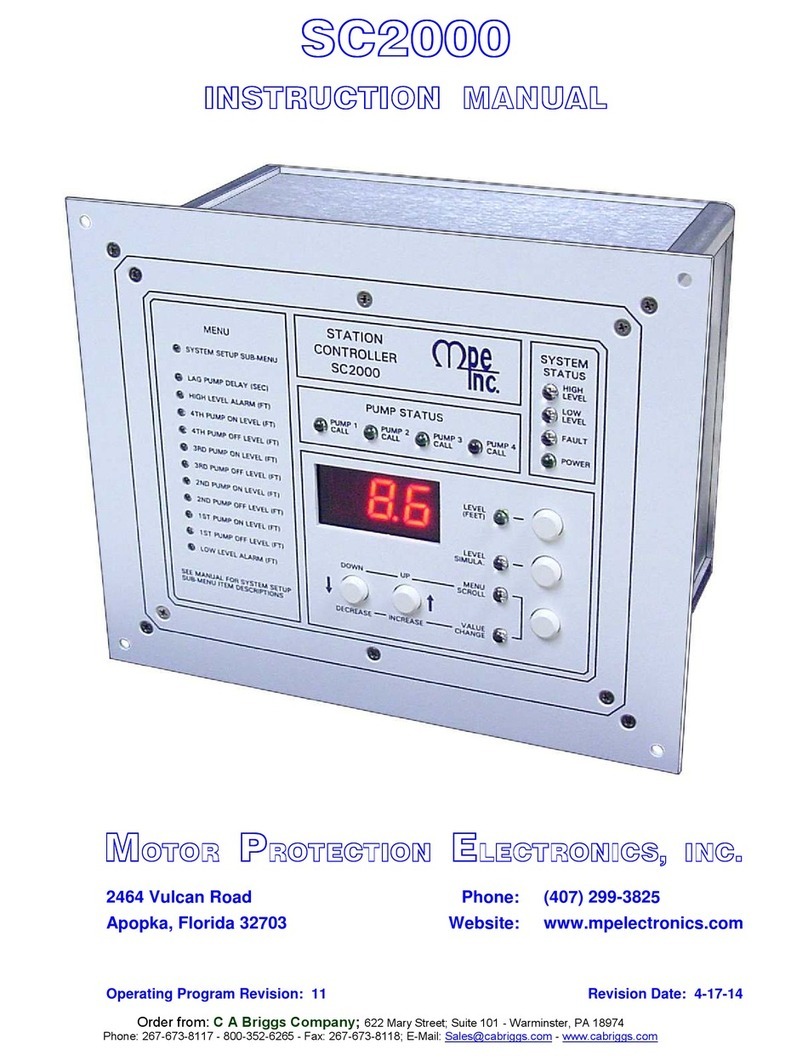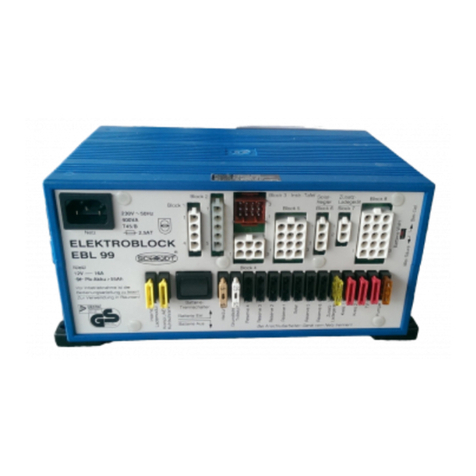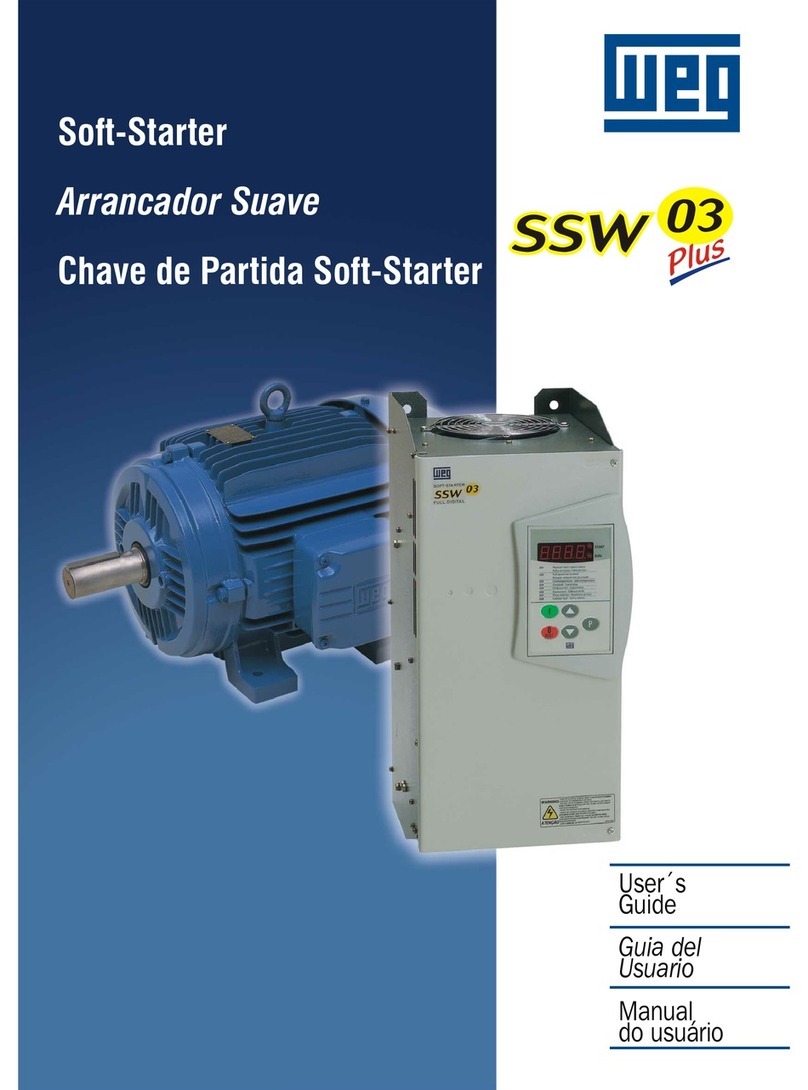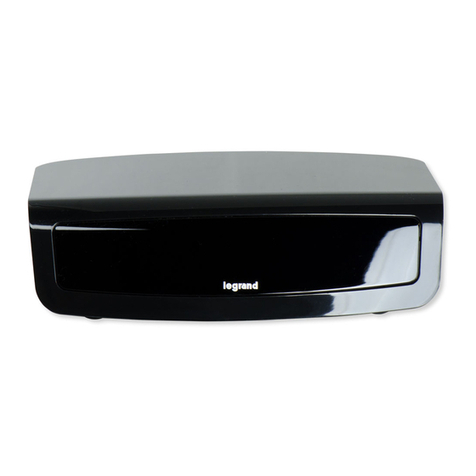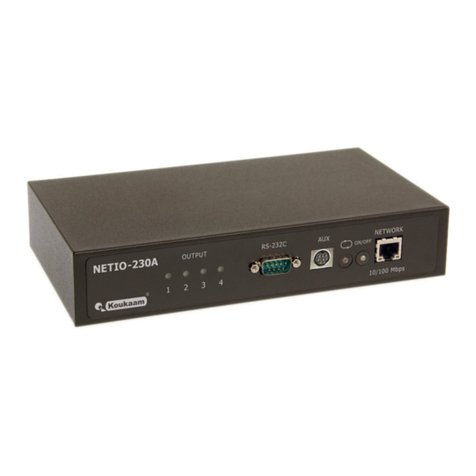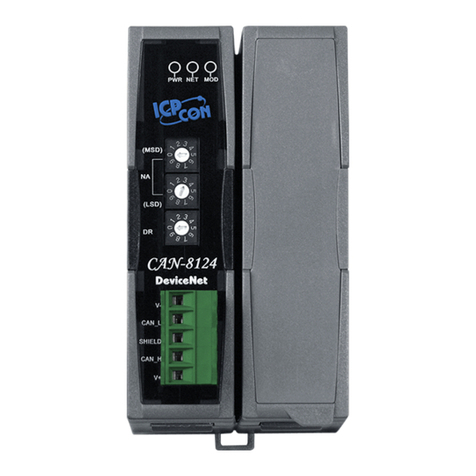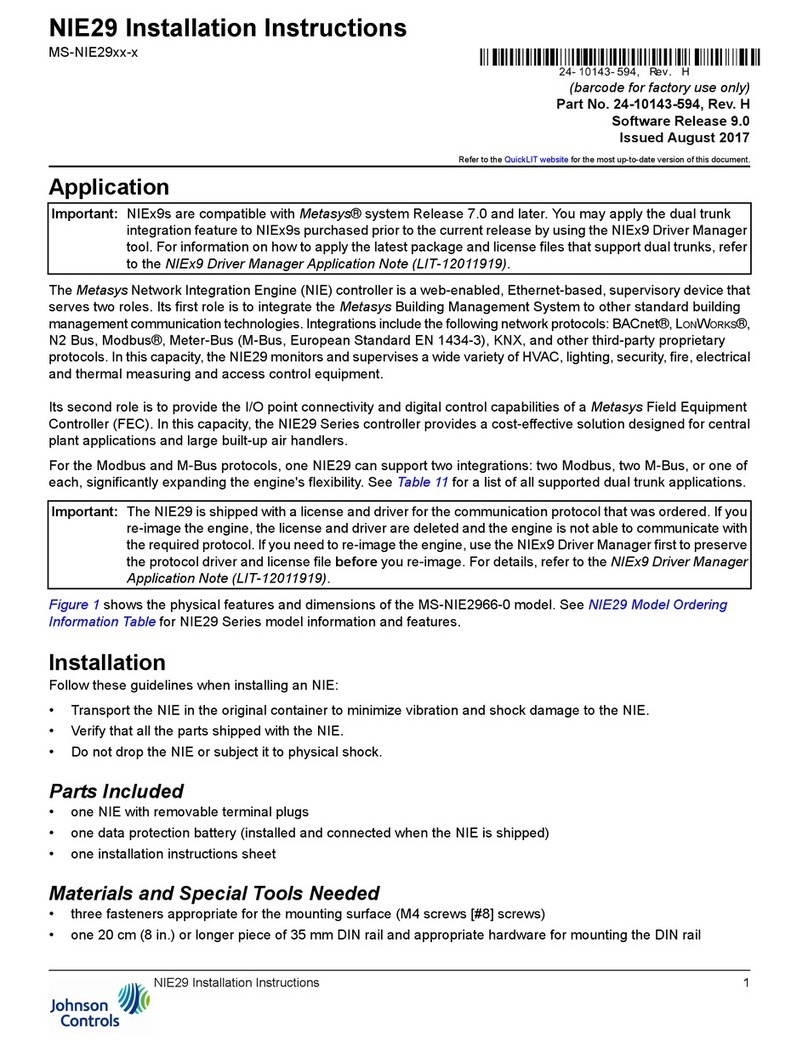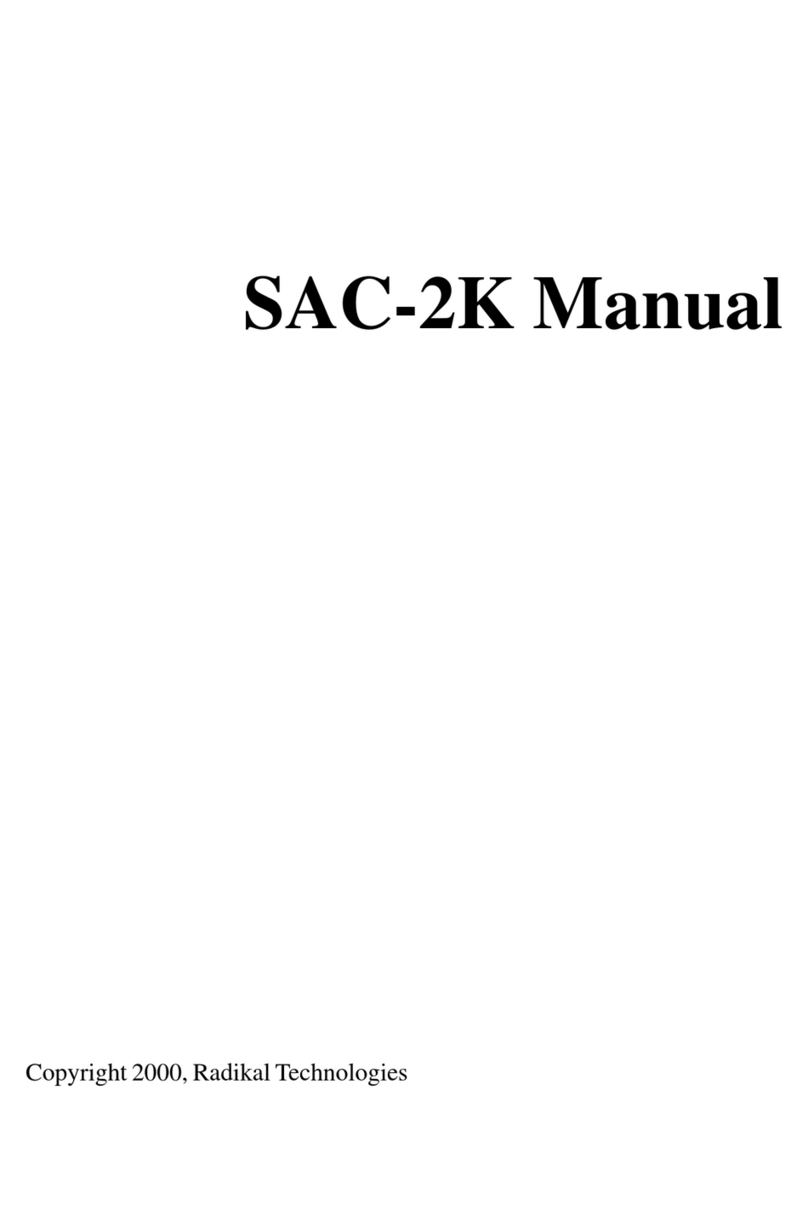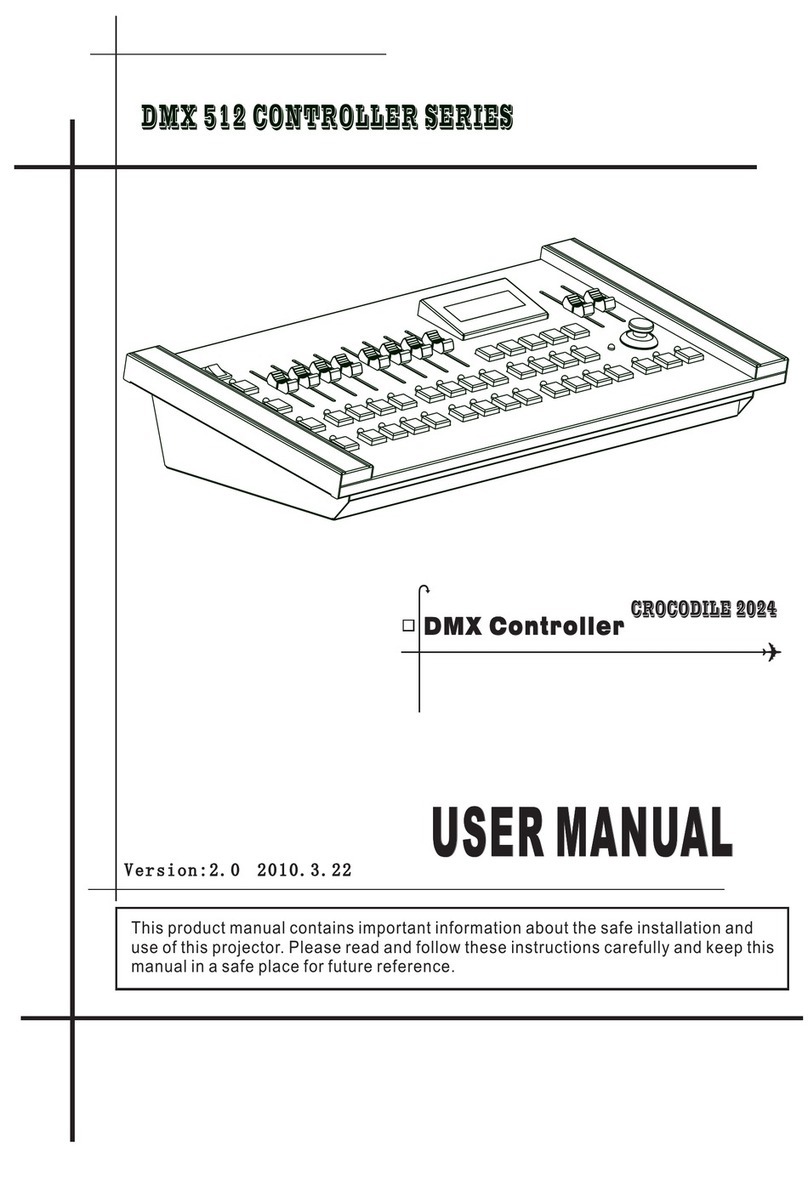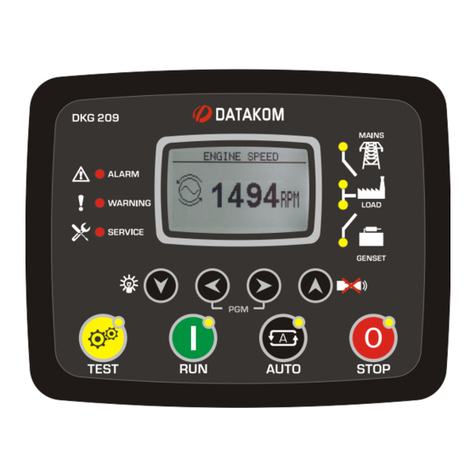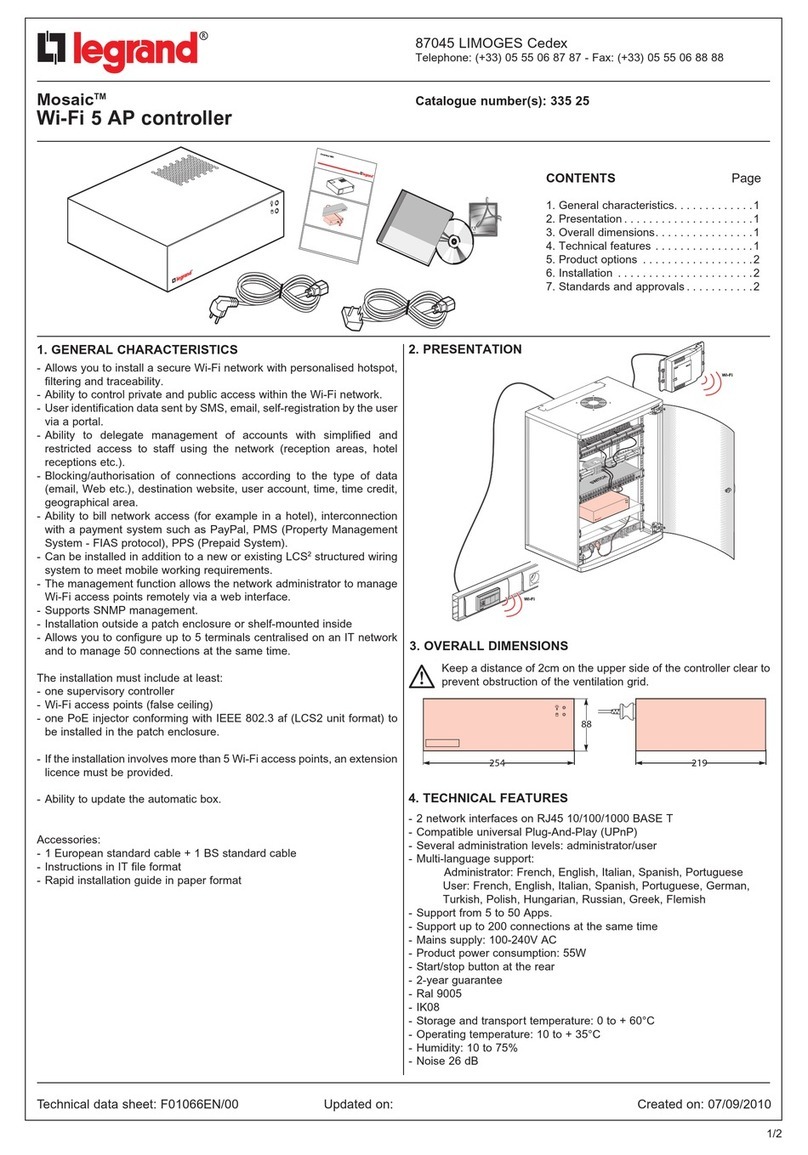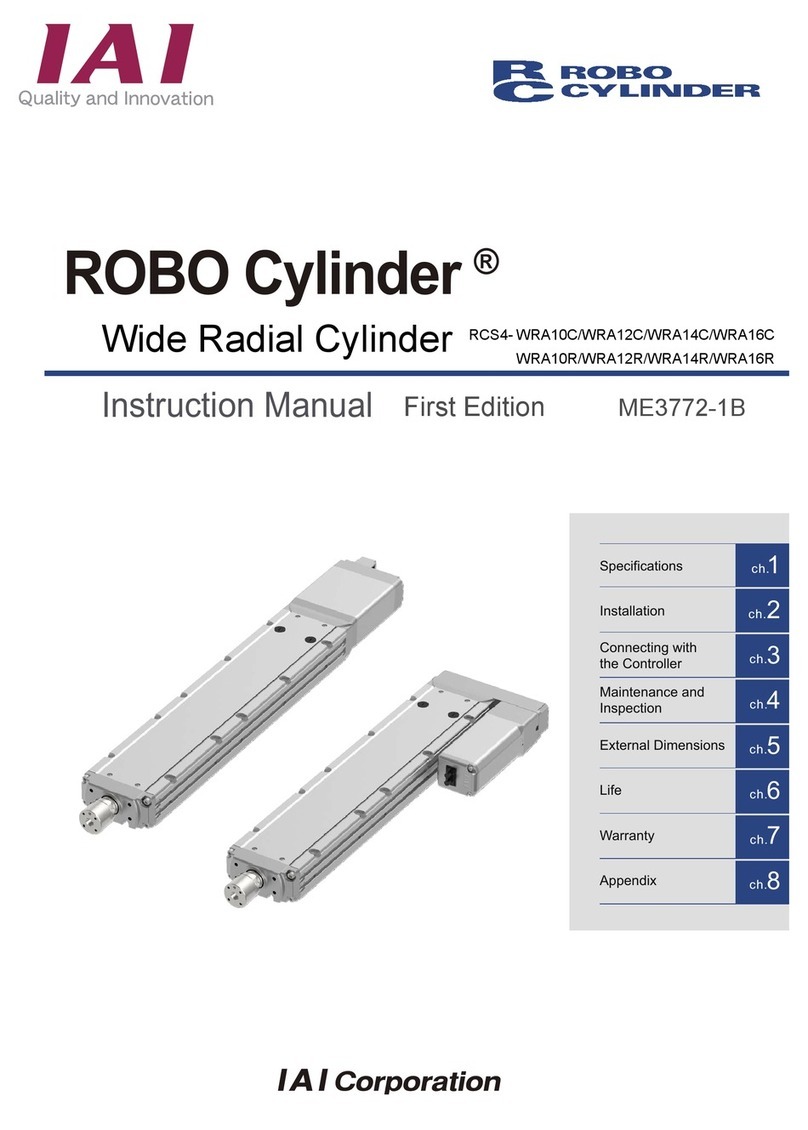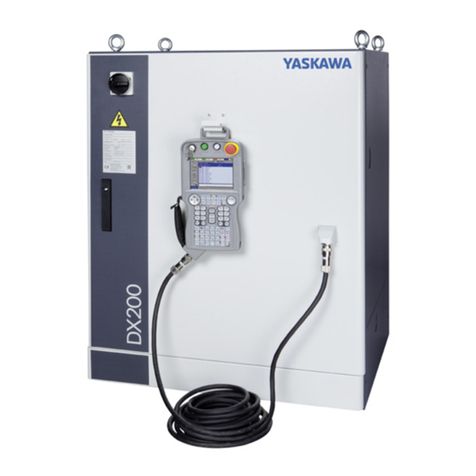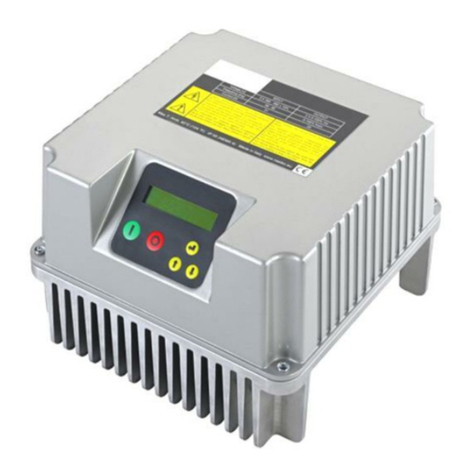MPE SC1000 User manual

SC1000
INSTRUCTION MANUAL
2464 Vulcan Road
Apopka, Florida 32703
Revision Date: 5-16-11
MOTOR PROTECTION ELECTRONICS, INC.
Phone: (407) 299-3825
Fax: (407) 294-9435
Operating Program Revision: 8
Order from: C A Briggs Company; 622 Mary Street; Suite 101 - Warminster, PA 18974
Phone: 267-673-8117 - 800-352-6265 - Fax: 267-673-8118; E-Mail: Sales@cabriggs.com - www.cabriggs.com

STATION CONTROLLER SC1000
• Simplex, Duplex, or Triplex Liquid Level Control
• Pump Down (Empty a Tank) or Pump Up (Fill a Tank)
• Where Connection to a SCADA System is Required
SPECIFICATIONS
APPLICATIONS
STANDARD FEATURES
• All Setup Parameters Values may be viewed or changed from the
front of the unit
• Level Input Source - Menu Selectable:
- Analog Level Input [4-20mA from Pressure Transducer]
- Level Probe [Conductance Probe with 10 Electrodes]
• Regulated +20VDC power for Analog Level Input
• RS-232 Serial Port with Modbus RTU Protocol
• High and Low Level Alarm Relays and Alarm Indication
• Adjustable Lag Pump(s) Delay
• Alternation Schemes - Menu Selectable:
- Standard Alternation
- Pump 1 Always Lead - Stays On with other Pumps
- Pump 1 Always Lead - Turns Off with other Pumps On
- Split Alternation - Pumps 1&2, and Pumps 3 Always Last
- Fixed Sequence - Pump 1 Always Lead
- Stepped On/Off - Only One Pump Runs at a Time
Alternator Logic Skips Disabled Pumps
First On - First Off or First On - Last Off Alternation
• Level Simulation (Automatically ends after 1 minute)
• 12 Discrete Inputs programmable for the following functions:
- Pump disable with HOA in OFF, or pump fault
- External Lead Pump Selector Switch
- All pump disable - for connection to Phase Monitor
- Limit number of pumps called while on emergency power
- Alternation by External Time Clock
- Freeze wet well level during a bubbler tube purge
- Float switch backup
- Low Level Pump Cutoff
- Start Flush Cycle
- A variety of SCADA functions
Status of Discrete Inputs may be viewed from front of Controller
• Backup Control, and High & Low Alarms using a Level Probe
• Output Relays may be programmed for control through SCADA
• Automatic Flush Cycle to reduce sludge build up
• Flow Calculator that provides the following Flow Data:
- Latest Inflow Rate
- Average Daily Inflow Total (Average of Last 7 Days)
- Pump Outflow Rate (Latest for Each Pump)
1
• 4-20mA Analog Level Input may be ordered as an Isolated Input
• Ethernet Port with the following protocols:
Modbus TCP or Modbus RTU
OPTIONAL FEATURES
• Input Power: 120 VAC ±10%, 13 VA max
• External Dimensions: 6.9” x 8.5” x 4.1”
• Agency Approvals: UL 508, CAN/CSA
• Ambient Operating Temperature:
-20°C to +65°C (-4°F to +149°F)
• Level Display: 3 Digit, 7 Segment LED
• Level Display Range: 0 - 999 feet
(Decimal Point Position is Selectable)
• Indicators: LED
• Color: White with Blue Lettering
• Relays: 6A @ 250VAC
• Analog Level Input: 4-20mA, 250ΩLoad,
Transient Protected
• Level Probe Inputs: ±8V, 60Hz Square
Wave, ±0.8mA max, Transient Protected
• Discrete Inputs: 24VDC, Transient
Protected
• Power for Discrete Inputs: Unregulated
+24VDC, Transient Protected
• Power for Analog Level Input: Regulated
+20VDC ±1V, Transient Protected
ORDERING INFORMATION
Part Number: SC1000 - XX
Blank = Non-Isolated Analog Level Input
S = Isolated Analog Level Input
Blank = RS232 Port
E = RS232 Port & Ethernet Port

2
On when Display Shows the Wet Well Level
Press to Display Wet Well Level
On when in Level Simulation Mode
Press to Enter the Level Simulation Mode
On when in Menu Scroll Mode
Press to Change Function of the
Up/Down Push-Buttons
On when in Value Change Mode
Press to Scroll Up the Menu, or to
Increase Parameter Value
Press to Scroll Down the Menu, or to
Decrease Parameter Value
Parameters Shown on Front of Controller:
The value of the Parameter is displayed
whenever the indicator next to the Parame-
ter label is on.
Parameters Shown on Front of Controller:
Press push-button PB-M until the Value
Change indicator comes on.
Parameters in the System Setup Sub-Menu:
The value of a Parameter in the System Setup Sub-Menu may be
viewed by using the push-button PB-M to toggle from the Parameter
number (P.13, for example) to the Parameter value.
Parameters in the System Setup Sub-Menu:
Press push-button PB-M until the Value Change indicator comes
on. The current value of the Parameter will then be displayed.
OPERATOR INTERFACE FUNCTIONS
Note: There is a 4 second Delay on Changing Parameter Values.
How to View a Setup Parameter Value
1. Press push-button PB-M until the Menu Scroll Mode indicator comes on.
2. Press push-button PB-D or PB-U as needed to arrive at the Parameter you wish to view.
How to Change a Setup Parameter Value
1. Press push-button PB-M until the Menu Scroll mode indicator comes on.
2. Press push-button PB-D or PB-U as needed to arrive at the Parameter you wish to change.
4. Press and hold for 4 seconds, either push-button PB-D or PB-U, to change the Parameter to the desired new value.
5. Press push-button PB-M or PB-L to exit the Value Change mode.
How to Simulate Levels
1. Press push-button PB-S.
Note: The Simulation starts from the actual level displayed prior to entering the Level Simulation mode.
2. Press push-button PB-D or PB-U as needed to change the simulated level.
3. To end the level simulation press push-button PB-L.
Note: If you do not exit the Level Simulation mode, normal operation will resume automatically 60 seconds after the
last time the PB-U, PB-D, or PB-S push-buttons were pressed.
3.
3.

3
Parameter
Default
Value
Current
Value Setting Definitions
- 2.0 feet Low Level Alarm SCADA Register 40021 Range: 0.1 - 99.9 feet
Note: To Disable Alarm see Parameter P.50.
- 3.0 feet 1st Pump Off Level SCADA Register 40013 Range: 0.2 - 99.9 feet
- 6.0 feet 1st Pump On Level SCADA Register 40012 Range: 0.2 - 99.9 feet
- 4.0 feet 2nd Pump Off Level SCADA Register 40015 Range: 0.2 - 99.9 feet
- 7.0 feet 2nd Pump On Level SCADA Register 40014 Range: 0.2 - 99.9 feet
- 4.5 feet 3rd Pump Off Level SCADA Register 40017 Range: 0.2 - 99.9 feet
- 8.0 feet 3rd Pump On Level SCADA Register 40016 Range: 0.2 - 99.9 feet
- 10.0 feet High Level Alarm SCADA Register 40020 Range: 0.5 - 99.9 feet
P.12 5 sec. Lag Pump(s) Delay Range: 1 - 100 seconds
P.13 3
Number of Pumps Present
1 = 1 Pump 2 = 2 Pumps 3 = 3 Pumps
P.14 3
Number of Pumps Allowed to Run at the Same Time
1 = 1 Pump 2 = 2 Pumps 3 = 3 Pumps
P.15 3
Number of Pumps Allowed to Run On Generator
1 = 1 Pump 2 = 2 Pumps 3 = 3 Pumps
Note: Must Connect Transfer Switch Contact to Discrete Input Programmed for Function 6.
P.16 1
Alternator Sequence Mode
1 = Standard Alternation
2 = Pump 1 Always Lead - Stays On With Other Pumps
3 = Pump 1 Always Lead - Turns Off With Other Pumps
4 = Split Alternation - Pumps 1&2, and Pump 3 Always Last
5 = Fixed Sequence - Pump 1 Always Lead
6 = Stepped On/Off - Only One Pump Runs at a Time
See Pages 9 - 11 for Sequence Descriptions.
P.17 2 Pump Stop Mode 1 = First On Last Off 2 = First On First Off
P.18 1
Automatic Alternation 1 = Enabled 2 = Disabled
Note: The Lead Pump may also be Set using Parameter P.39.
P.19 1
Pump Up or Down Mode
1 = Pump Down - Empty a Tank 2 = Pump Up - Fill a Tank
Note: When Parameter P.19 is Changed New Default Level Parameter Values will be loaded.
P.24 11.5 feet
Level Input Calibration - Span Range: 0.9 - 99.9 feet
Notes:
1. 20mA is Typically Applied to the Analog Input while Setting the Span. See Page 15.
2. Parameter P.24 Shows the Wet Well Level, while allowing the Up & Down Push-buttons to
Change the Internal Number used to Calculate the Displayed Level.
3. When Controller is set to Operate using a Level Probe, Parameter P.24 shows “77.7”.
P.25 0.0 feet
Level Input Calibration - Zero
Notes:
1. 4.0mA is Typically Applied to the Analog Input while Setting the Zero. See Page 15.
2. Parameter P.25 Shows the Wet Well Level, while allowing the Up & Down Push-buttons to
Change the Internal Number used to Zero the Displayed Level.
3. When Controller is set to Operate using a Level Probe, Parameter P.25 shows “77.7”.
P.28 1 Slave Address See Page 19.
P.29 -P.32 - RS232 Serial Port Setup See Page 20.
MENU - SYSTEM SETUP All Level Settings Have the Decimal Point Artificially Inserted Based on Parameter P.36.

4
Parameter
Default
Value
Current
Value
Setting Definitions
P.33 1 Register Access Mode See Page 19
P.35 1 sec.
Stop Pump Delay Range: 1 - 100 seconds
Note: This is the Time Period that the Wet Well Level Must Remain At or Below (At or Above for
Pump Up P.19 = 2) the Respective OFF Level Setting in order to Turn Off a Pump.
P.36 1
Display Decimal Point Position
0 = No Decimal Point 1 = XX.X 2 = X.XX
P.37 1 min.
Pump Re-enable Delay after Float Backup Low Level (High Level)
Notes: Range: 1 - 255 minutes
1. Pump Down (Parameter P.19 = 1) - Delay Starts when the Low Level Float Input Opens.
2. Pump Up (Parameter P.19 = 2) - Delay Starts when the High Level Float Input Opens.
P.38 1 min.
Delay Canceling Remote Control Commands
Notes: Delay Range: 1 - 254 minutes
1. Delay Starts when Serial Communication is Lost.
2. To Allow all Remote Commands to Remain in Effect (Until Power Loss) Set P.38 = 255.
P.39 0
Forced Lead Pump Position 0 = Normal Alternation
SCADA Register 40022 1(2,3) = Pump 1(2,3) as Lead
P.40 -P.43 - Flush Cycle Setup See Page 16.
P.44 -P.47 - Flow Calculator Setup See Pages 17 - 18.
P.49 240
Analog Level Input - Signal Conditioning Control Range: 1 - 254
10 = Very Slow 100 = Slow 240 = Normal 250 = Fast
P.50 1
Low Level Alarm Mode 0 = Disabled 1 = Enabled
Note: Setting “0” Disables Low Level Alarms from the Analog Level Input or Level Probe Inputs.
FLC - Fault Code SCADA Register 40047 See Fault Code Table on Pages 13 -14.
Note: This Automatically Returns to Zero when the Fault Clears (Except for Faults 20-29).
LFC - Last Fault Code SCADA Register 40048 See Fault Code Table on Pages 13 -14.
Note: This is a Copy of the Last Non-Zero Fault Code shown on Parameter FLC.
oPr - Operating Program Revision Number - Controller SCADA Register 40063
EPr - Operating Program Revision Number - Ethernet Board
MENU - SYSTEM SETUP All Level Settings Have the Decimal Point Artificially Inserted Based on Parameter P.36.

5
Parameter
Default
Value
Current
Value Setting Definitions
F.01 1
Discrete Input 1
Function
Function of Input: Connect To:
0 = No Function
1 = Pump 1 Disable …….………...…………...…. HOA and Fault Logic
2 = Pump 2 Disable …….….....…..……….….….. HOA and Fault Logic
3 = Pump 3 Disable ………..……..…….…..…..... HOA and Fault Logic
4 = Level Freeze ……………...………....…. Bubbler Tube Purge Logic
5 = External Alternation ………...……......………. External Time Clock
6 = On Generator ………………….……….. Automatic Transfer Switch
7 = All Pump Disable …………...…………...…………... Phase Monitor
8 = Sequence Input 1 ……....…..…… Lead Select Switch - 1 as Lead
9 = Sequence Input 2 ….…….........… Lead Select Switch - 2 as Lead
10 = Sequence Input 3 …...…...…….… Lead Select Switch - 3 as Lead
11 = Low Level Alarm ……..………..…..…….… Low Level Float Switch
12 = High Level Alarm …………………...…..… High Level Float Switch
13 = Telemetry E ………...…………………....……… Telemetry Contact
14 = Telemetry F …….………………….....…….…… Telemetry Contact
15 = Telemetry G ……..……………………........…… Telemetry Contact
16 = Telemetry J ………………………….…..….…… Telemetry Contact
17 = Telemetry K ……………………………...……… Telemetry Contact
18 = Telemetry L ……………………….…..….……… Telemetry Contact
19 = Telemetry A ………………………..….…….…… Telemetry Contact
20 = Telemetry B ……………………...….….…..…… Telemetry Contact
21 = Telemetry C ……….…………………...…...…… Telemetry Contact
22 = Telemetry D ………………………...…..……..… Telemetry Contact
23 = Normal Pump Operation Disable ......................….... Fault Contact
24 = Float Backup – Low Level .….………........ Low Level Float Switch
25 = Float Backup – Off Level ….……….….….... Off Level Float Switch
26 = Float Backup – 1ST On Level ……...... 1ST On Level Float Switch
27 = Float Backup – 2ND On Level ……..... 2ND On Level Float Switch
28 = Float Backup – 3RD On Level ……..... 3RD On Level Float Switch
29 = Float Backup – High Level .………...…..... High Level Float Switch
30 = Start Flush Cycle …………………...……...…. External Time Clock
Notes:
1. Function of Discrete Inputs may be set to “0” when Input are used
only to collect data for SCADA and no other Function is desired.
Data must be read from SCADA Registers 40035 - 40036.
2. All Discrete Inputs may be read from SCADA Registers 40035 -
40036, regardless of the Function assigned to the Input.
3. Functions 13 - 22 are used to assign a Discrete Input to a specific
Bit in a SCADA Register. See page 22.
4. Function 23 disables normal pump operation, but allows operation
from Float Backup or Level Probe Backup. See Fault Code 15.
5. Function 5 requires the setup of Parameter P.18.
6. Function 6 requires the setup of Parameter P.15.
7. Functions 24 - 29 - See page 34.
F.02 2
Discrete Input 2
Function
F.03 3
Discrete Input 3
Function
F.04 4
Discrete Input 4
Function
F.05 5
Discrete Input 5
Function
F.06 6
Discrete Input 6
Function
F.07 7
Discrete Input 7
Function
F.08 8
Discrete Input 8
Function
F.09 9
Discrete Input 9
Function
F.10 10
Discrete Input 10
Function
F.11 11
Discrete Input 11
Function
F.12 12
Discrete Input 12
Function
F.19 1
Level Input Source
1 = Analog Level Input (4-20mA) on J21 2 (or 3) = Level Probe Input on J25
Note: Setting 3 - Flashes the Level Probe Electrode Number while changing a level Parameter.
F.20 12 inch Level Probe Electrode Spacing Range: 3 - 24 inches
F.21 0.0 feet Level Offset Range: 0.0 - 5.0 feet
Note: This adds to the level from the Analog Level Input or Level Probe Input.
F.22 100
Level Probe Sensitivity Range: 90 - 210
100 = Typical Sewage 150 = Light Sewage
Check value of Parameter L.10 with Electrode 10 covered, add 40 to it, and enter value for F.22.
MENU - SYSTEM SETUP All Level Settings Have the Decimal Point Artificially Inserted Based on Parameter P.36.

6
Parameter
Default
Value
Current
Value Setting Definitions
F.31 1
HI Relay Output Function
0 = Disabled 1 = High Level Alarm 2 = Remote Control (SCADA Coil 25)
Note: High Level indicator on front of unit will operate regardless of setting.
F.32 1
LO Relay Output Function
0 = Disabled 1 = Low Level Alarm 2 = Remote Control (SCADA Coil 26)
Note: Low Level indicator on front of unit will operate regardless of setting.
F.33 1
P1 Relay Output Function
0 = Disabled 1 = Pump 1 Call 2 = Remote Control (SCADA Coil 27)
Note: When set on “0” or “2” Pump 1 will be skipped over in all Alternation Sequence Modes.
F.34 1
P2 Relay Output Function
0 = Disabled 1 = Pump 2 Call 2 = Remote Control (SCADA Coil 28)
Note: When set on “0” or “2” Pump 2 will be skipped over in all Alternation Sequence Modes.
F.35 1
P3 Relay Output Function
0 = Disabled 1 = Pump 3 Call 2 = Remote Control (SCADA Coil 29)
Note: When set on “0” or “2” Pump 3 will be skipped over in all Alternation Sequence Modes.
E.01 -E.62 - Ethernet Port Setup See Page 21.
Level Probe Backup Functions
0 = Function Not Used
1 = Electrode Input 1 on Connector J25-1
2 = Electrode Input 2 on Connector J25-2
3 = Electrode Input 3 on Connector J25-3
4 = Electrode Input 4 on Connector J25-4
5 = Electrode Input 5 on Connector J25-5
6 = Electrode Input 6 on Connector J25-6
7 = Electrode Input 7 on Connector J25-7
8 = Electrode Input 8 on Connector J25-8
9 = Electrode Input 9 on Connector J25-9
10 = Electrode Input 10 on Connector J25-10
b.01 0
Low Level Alarm
b.02 0
Pump Control – Off Level
b.03 0
Pump Control – 1ST On Level
b.04 0
Pump Control – 2ND On Level
b.05 0
Pump Control – 3RD On Level
b.06 0
High Level Alarm
Notes For Level Probe Backup Functions: For status of Level Probe inputs see Coils 583 - 592 in SCADA Register 40037.
1. When the controller is set up to follow a 10 Electrode Conductance Level Probe as the primary level input source (Parameter F.19
= 2), the backup functions described here are not needed and will not operate.
2. If a Function (such as Pump Control – 3RD On Level) is not desired set the respective parameter equal to zero.
3. An effective Backup Pump Control would involve having a 3 point Level Probe placed high in the wet well. The Level Probe would
be connected to Connector J25 terminals 1, 2, and 3. The Off Level should be made to operate from the bottom Electrode by
setting Parameter b.02 = 3. The 1ST On Level should be set to operate from Electrode 2 by setting Parameter b.03 = 2. The
2ND On Level should be set to operate from Electrode 1 by setting Parameter b.04 = 1. If pump three is present set the 3RD On
Level to operated from Electrode 1 by setting Parameter b.05 = 1.
4. If a Backup High Level Alarm is desired, set Parameter b.06 to the number of the Electrode Input that the High Level Probe is con-
nected to. This feature is for alarm and telemetry only and will not function as a redundant pump call. See SCADA notes page 26.
5. If a Backup Low Level Alarm is desired, set Parameter b.01 to the number of the Electrode Input that the Low Level Probe is con-
nected to. This feature is for alarm and telemetry only and will not function as a redundant pump off. See SCADA notes page 26.
6. Whenever the Backup Pump Control is active the Fault indicator will be on and Fault Code of 30 will be present in Parameter FLC,
and set Coil 15 in SCADA Register 40001.
MENU - SYSTEM SETUP

7
Parameter Data Description
L.01 Electrode 1 Status Value
Level Probe Electrode Status Values
Normal Range when Un-Covered: 240 - 255
Normal Range when Covered by Typical Sewage: 55 - 70
Notes:
1. The Controller compares each of the Electrode Status Values with what is set on
Parameter F.22. When the value drops below the setting on Parameter F.22, the
Controller logic considers the Electrode to be covered by liquid.
2. Parameters L.01 - L.10 are also used to diagnose Out of Sequence Faults (Fault
Codes 21 - 29).
3. For the status of the Level Probe inputs see Coils 583 - 592 in SCADA Register
40037.
L.02 Electrode 2 Status Value
L.03 Electrode 3 Status Value
L.04 Electrode 4 Status Value
L.05 Electrode 5 Status Value
L.06 Electrode 6 Status Value
L.07 Electrode 7 Status Value
L.08 Electrode 8 Status Value
L.09 Electrode 9 Status Value
L.10 Electrode 10 Status Value
L.11
Level Probe Test Signal Status Normal Range: 230 - 254
Note: This is a Measure of the ±8V, 60Hz Square Wave Sent Out to Each Electrode to read the level. If the value is below
210, a malfunction has occurred in the circuit that provides the Square Wave used to read the level. In this case the wet
well level display will show zero, the Fault indicator will be turned on, and Fault Code 20 will be generated.
FLH Flow Calculator - Latest Inflow Rate FLH , FLL Gallons Per Minute
See pages 17 - 18. SCADA Register 40080
FLL
FdH Flow Calculator - Average Daily Inflow Total FdH , FdL Units set by Parameter P.45.
See pages 17 - 18. SCADA Register 40081
FdL
F1H Flow Calculator - Pump 1 Outflow Rate F1H , F1L Gallons Per Minute
See pages 17 - 18. SCADA Register 40082
F1L
F2H Flow Calculator - Pump 2 Outflow Rate F2H , F2L Gallons Per Minute
See pages 17 - 18. SCADA Register 40083
F2L
F3H Flow Calculator - Pump 3 Outflow Rate F3H , F3L Gallons Per Minute
See pages 17 - 18. SCADA Register 40084
F3L
MENU - DATA DISPLAY

8
Parameter Data Description
n.01 Discrete Input 1 Status
Discrete Input Status
0 = Input Open
1 = Input Closed
Notes:
1. Discrete Input Status is used when troubleshooting the
wiring and logic connected to the Discrete Inputs.
2. Discrete Input Status data may be read by SCADA at
Registers 40035 - 40036. See page 23.
n.02 Discrete Input 2 Status
n.03 Discrete Input 3 Status
n.04 Discrete Input 4 Status
n.05 Discrete Input 5 Status
n.06 Discrete Input 6 Status
n.07 Discrete Input 7 Status
n.08 Discrete Input 8 Status
n.09 Discrete Input 9 Status
n.10 Discrete Input 10 Status
n.11 Discrete Input 11 Status
n.12 Discrete Input 12 Status
d.01 Voltage of +5 Volt Power Supply SCADA Register 40049 Normal Range: 8.5V - 11.3V
Note: Voltage is measured ahead of Voltage Regulator.
d.02 Voltage of +24 Volt Power Supply SCADA Register 40050 Normal Range: 21.1V - 25.5V
d.07 Serial Communication Activity Indicator See page 27.
d.08 Serial Communication – Shows the Address of the Last Slave Polled by the Master.
See page 27.
d.09 Serial Communication – Shows the Last Modbus Function Code Received. See page 27.
d.10-d.86 Serial Communication – Shows the Entire Rest of the Last Modbus Message Received.
MENU - DATA DISPLAY

ALTERNATION SEQUENCE
STANDARD ALTERNATION Parameter P.16 = 1
9
Notes:
1. Unless there is some special circumstance that requires a more complicated
pump call sequence, this is the sequence that should be used.
2. Parameter P.17 must be used to select either First On Last Off or First On
First Off.
3. Discrete Inputs programmed as Pump 1-3 Disable inputs may be used to
disable pumps.
4. Discrete Inputs programmed as Sequence Inputs 1-3 may be used to set
the lead pump.
5. Parameter P.39 may be used to set the lead pump.
6. A Discrete Input programmed for External Alternation (Function 5) may be
used to force alternation. When this feature is used, Automatic Alternation
would normally be disabled by setting Parameter P.18 to Disabled.
7. If connected to a SCADA system, alternation may be initiated by momentar-
ily setting Coil 136, or by forcing the lead pump by writing to Register 40022
(Same as Parameter P.39).
Notes:
1. This sequence is used when it is required that pump 1 always be lead pump.
This sequence keeps pump 1 on, when the other pumps are called to run.
2. Parameter P.17 must be used to select either First On Last Off or First On
First Off.
3. Discrete Inputs programmed as Pump 1-3 Disable inputs may be used to
disable pumps.
4. For Triplex applications Discrete Inputs programmed as Sequence Inputs 2
-3 may be used to set the lead pump.
5. For Triplex applications Parameter P.39 may be used to set the lead pump
among pumps 2 and 3.
6. If pump 1 is disabled another pump will be called in its place.
7. A Discrete Input programmed for External Alternation (Function 5) may be
used to force alternation. When this feature is used, Automatic Alternation
would normally be disabled by setting Parameter P.18 to Disabled.
8. If connected to a SCADA system, alternation may be initiated by momentar-
ily setting Coil 136, or by forcing the lag pump by writing to Register 40022
(Same as Parameter P.39).
PUMP 1 ALWAYS LEAD
Stays On With Other Pumps Parameter P.16 = 2
Movement of Lead Pump Upon Alternation

ALTERNATION SEQUENCE
SPLIT ALTERNATION
Parameter P.16 = 3
10
Notes:
1. This sequence is used when it is required that pump 1 always be lead, and
when it must be turned off when another pump(s) comes on. When a pump
from the second group is required, pump 1 is first turned off, then after the
Lag Pump Delay, the other pump is turned on.
2. For Triplex applications Parameter P.17 must be used to select either First
On Last Off or First On First Off.
3. Discrete Inputs programmed as Pump 1-3 Disable inputs may be used to
disable pumps.
4. For Triplex applications Discrete Inputs programmed as Sequence Inputs 2-
3 may be used to set the lead pump.
5. For Triplex applications Parameter P.39 may be used to set the lead pump
among pumps 2 and 3.
6. If pump 1 is disabled, another pump will Not be called in its place. The 1ST
Pump On/Off Level parameters are dedicated to pump 1 and will not call
another pump.
7. A Discrete Input programmed for External Alternation (Function 5) may be
used to force alternation. When this feature is used, Automatic Alternation
would normally be disabled by setting Parameter P.18 to Disabled.
8. If connected to a SCADA system, alternation may be initiated by momentar-
ily setting Coil 136, or by forcing the lag pump by writing to Register 40022
(Same as Parameter P.39).
Notes:
1. This sequence is used when it is required that pumps 1 and 2 alternate
among themselves and pump 3 must always be called last.
2. For Triplex applications Parameter P.17 must be used to select either First
On Last Off or First On First Off.
3. Discrete Inputs programmed as Pump 1-3 Disable inputs may be used to
disable pumps.
4. Discrete Inputs programmed as Sequence Inputs 1-2 may be used to set the
lead pump.
5. Parameter P.39 may be used to set the lead pump. Setting Parameter P.39
on 3 has no effect.
6. If either Pump 1 or 2 is disabled, then Pump 3 will be called to take its place.
7. A Discrete Input programmed for External Alternation (Function 5) may be
used to force alternation. When this feature is used, Automatic Alternation
would normally be disabled by setting Parameter P.18 to Disabled.
8. If connected to a SCADA system, alternation of Pumps 1 and 2 may be initi-
ated by momentarily setting Coil 136, or by forcing the lead pump position
by writing to Register 40022 (Same as Parameter P.39).
PUMP 1 ALWAYS LEAD
Turns Off With Other Pumps On
Parameter P.16 = 4
Movement of Lead Pump Upon Alternation

ALTERNATION SEQUENCE
FIXED ALTERNATION Parameter P.16 = 5
11
Notes:
1. This sequence is used when no alternation is required and when pump 1
should normally be lead pump. Other pumps may be made lead by setting
Parameter P.39.
2. Discrete Inputs programmed as Pump 1-3 Disable inputs may be used to
disable pumps.
3. Discrete Inputs programmed as Sequence Inputs 1-3 may be used to set the
lead pump.
4. Parameter P.39 may be used to set the lead pump.
5. The Pump Stop Mode (Parameter P.17) has no effect on this sequence.
6. Automatic Alternation Enable/Disable (Parameter P.18) has no effect on this
sequence.
7. The External Alternation feature will not function when using this sequence.
8. If connected to a SCADA system, the lead pump position may be set by
writing to Register 40022 (Same as Parameter P.39).
Notes:
1. This sequence is used in stations where there is a significant difference in
the size of the pumps, and when only one pump is to be allowed to run at a
time. When there is a need for more pumping, the smaller pump is turned
off and the next larger pump is called to run. As the need for pumping de-
creases, the larger pump is turned off and a smaller pump is called to run in
its place (provided the Off Levels are staggered).
2. The Lag Pump Delay operates to give the check valve of the pump being
turned off time to close before another pump is called to run.
3. Discrete Inputs programmed as Pump 1-3 Disable inputs should be used to
disable pumps that are not able to run. It is critical that the largest pump in
the group, have some type of pump fault logic connected to the respective
Pump Disable discrete input.
4. Discrete Inputs programmed as Sequence Inputs 1-3 will not function when
using this sequence.
5. Parameter P.39 has no effect on this sequence.
6. The Pump Stop Mode (Parameter P.17) has no effect on this sequence.
7. Automatic Alternation Enable/Disable (Parameter P.18) has no effect on this
sequence.
8. The External Alternation feature will not function when using this sequence.
9. The On Generator (Parameter P.15) has no effect on this sequence.
STEPPED ON/OFF SEQUENCE
Only One Pump Runs at a Time Parameter P.16 = 6

SYSTEM STATUS
12
High Level Alarm
• Upon a High Level Alarm, the indicator will come on and the relay contacts will close.
• A High Level Alarm is delayed for ten seconds after power is applied.
• The High Level Alarm relay contacts will be closed when there is no power on the controller.
• The moment electrical power is applied to the controller, the High Level Alarm relay contacts open.
• The High Level Alarm relay contacts will close if there is a complete failure of the controller.
• The High Level Alarm will be activated as the level rises to or above the High Level Alarm level setting.
• A High Level float will activate the alarm. The Discrete Input used must be assigned Function 12 or 29.
• A High Level from a Level Probe input will activate the alarm. See Parameter b.06.
• With the Level Input Source set for the Level Probe (Parameter F.19 = 2), if not already on, the High
Level Alarm will be activated when Electrode 1 is covered with liquid.
Low Level Alarm
• Upon a Low Level Alarm, the indicator will come on and the relay contacts will close.
• A Low Level Alarm is delayed for 90 seconds after power is applied.
• The Low Level Alarm relay contacts will be open when there is no power on the controller.
• The Low Level Alarm will be activated when the level is at or below the Low Level Alarm level setting.
• A Low Level float will activate the alarm. The Discrete Input used must be assigned Function 11 or 24.
• A Low Level from a Level Probe input will activate the alarm. See Parameter b.01.
• The Low Level Alarm will not function as a redundant pump off, except for the Low Level Alarm from
Float Backup using a Discrete Input programmed for Function 24, which will turn off the pumps.
• With the Level Input Source set for the Level Probe (Parameter F.19 = 2), if not already on, the Low
Level Alarm will be activated when Electrode 10 is uncovered, unless it is disabled using Parameter
P.50.
• Low Level Alarm operation may be disabled by setting Parameter P.50 = 0. This disables Low Level
Alarm operation from either the Analog Level Input (Parameter F.19 = 1) or from a Level Probe
(Parameter F.19 = 2). However, it will not disable alarm operation from a Low Level float input using a
Discrete Input (Function 11 or 24), or from the Backup Low Level Probe input (See Parameter b.01).
Fault Indication
The Fault indicator shows when there is something wrong with the system, and that there is a non-zero
Fault Code present in Parameter FLC. Please see the Fault Code Table on Pages 13 - 14.
Fault Code - Parameter FLC
The current Fault Code may be viewed at Parameter FLC. Fault Codes 20 - 29 latch into memory but are
reset when the power is cycled, or may be reset by pressing the down push-button while viewing the Fault
Code. The Fault Code may also be reset remotely by setting Coil 31 in SCADA Register 40002.
The Last Fault Code (Parameter LFC) is a copy of the last non-zero Fault Code that was present in Pa-
rameter FLC. Parameter LFC is reset when power is cycled, or may be reset by pressing the down push-
button while viewing the Last Fault Code. The Last Fault Code may also be reset remotely by setting Coil
31 in SCADA Register 40002.
Last Fault Code - Parameter LFC

13
Fault
Code Description of Condition
0 Normal
1 Communication Fault - Overrun Error reading incoming message.
2 Communication Fault - Time out error reading incoming message.
3 Communication Fault - Time out error responding to message.
4 Communication Fault - Incoming message failed Checksum Test.
5 Communication Fault - Invalid Modbus Function Code.
6 Communication Fault - Trying to preset more than 35 registers using Function Code No. 16.
7 Communication Fault - Trying to force to more than 100 Coils using Function Code No. 15.
8 Parameter Setup Fault - More than one Discrete Input is assigned to the same Function.
9 Parameter Setup Fault - Pump On & Pump Off parameters are set too close together. (They must be at least
0.2 feet apart with P.36 = 1, or 2 feet apart with P.36 = 0, or 0.02 feet apart with P.36 = 2.)
10 Parameter Setup Fault - Pump On & Pump Off parameters are upside down. (Pump Off Level must be lower
than the Pump On Level, for a pump down application.)
13 Communication Fault - The UART detected a Framing Error reading the incoming message. It did not find Stop
Bit where expected.
14 Communication Fault - Noise Detected on incoming message.
15 Normal Pump Operation Disabled - Discrete Input programmed for Function 23 is closed. Pump Operation will
only be allowed from Float Backup or Level Probe Backup.
16 Pump Operation on Float Backup.
17 Backup Float Switch Out of Sequence.
Note: Fault will clear when normal operation is verified.
18 All Pump Disable - Discrete Input programmed for Function 7 is closed (Typically connected to Phase Monitor).
19
One of the Pump On or Pump Off level control Parameters (or Parameters P.42, or P43) is set too low. One of
them is set in the part of the display range that is artificially created by the Level Offset Parameter F.21. See
page 5 for a description of Parameter F.21. All level control Parameters must be set higher than what is set on
Parameter F.21.
20 Level Probe Fault - Test Signal Status Below Normal Range. See notes on Parameter L.11 on page 7.
Fault Codes 21 - 29 Level Probe Fault
Electrodes Covered Out of Sequence
Notes:
1. Level Probe Fault Codes 20-29 must be present for at
least 60 seconds for the fault to be latched into memory.
2. To reset the fault, scroll to and view Parameter FLC. Re-
cord the Fault Code, then press the Down push-button
while viewing the Fault Code. Cycling power to the con-
troller will also reset the Fault Code.
3. The analog value associated with each of the Level Probe
Electrodes may be viewed from Parameters L.01 - L.10.
See page 7.
21 Electrode 1 Covered before Electrode 2
22 Electrode 2 Covered before Electrode 3
23 Electrode 3 Covered before Electrode 4
24 Electrode 4 Covered before Electrode 5
25 Electrode 5 Covered before Electrode 6
26 Electrode 6 Covered before Electrode 7
27 Electrode 7 Covered before Electrode 8
28 Electrode 8 Covered before Electrode 9
29 Electrode 9 Covered before Electrode 10
30 Pump(s) are Called to Operate by the Level Probe Backup Pump Control.
FAULT CODE TABLE

14
Fault
Code Description of Condition
31 Communication Fault - Write Attempt to Register Not Marked for “Write” using Function Code No. 05.
32 Communication Fault - Write Attempt to Register Not Marked for “Write” using Function Code No. 06.
33 Communication Fault - Write Attempt to Register Not Marked for “Write” using Function Code No. 15.
34 Communication Fault - Write Attempt to Register Not Marked for “Write” using Function Code No. 16.
35 Communication Fault - Write Attempt made with Register Access Mode Parameter set for Read Only.
36 Flow Calculator Setup Fault - Average Daily Inflow Total is too Large to Display. Set Parameter P.45 = 2.
FAULT CODE TABLE

15
ANALOG LEVEL INPUT (4-20mA Input) – CALIBRATION PROCEDURE
The following calibration is for the 4-20mA Analog Level Input (Parameter F.19 = 1) and does not apply when a 10 Electrode
Level Probe is used (Parameter F.19 = 2).
Parameters P.24 and P.25 show the Wet Well Level, while allowing the Up & Down push-buttons to be used to change the
internal numbers involved in calculating the displayed level. Therefore, the appropriate 4-20mA signal must be applied to the
Level Input during each step of the calibration procedure.
If Parameters P.24 and P.25 show 77.7 feet in the display, then Parameter F.19 is setup to follow the Level Probe input. To
calibrate the level display when using the Level Probe, the distance between the electrodes must be set on Parameter F.20,
and Parameters P.24 and P.25 are not used.
The 4-20mA Analog Level Input signal conditioning may be slowed down or speeded up using Parameter P.49.
LEVEL INPUT ZERO - Parameter P.25
This parameter is used to make the display read zero feet of water with a Wet Well Level input of 4.0mA.
Calibration Procedure:
1. Apply a 4.0mA signal to the Wet Well Level Analog Input.
(Alternate Procedure - Pull the pressure transducer or bubbler tube out of the water.)
2. Scroll to the place in the System Setup Sub-Menu where Parameter P.25 is displayed.
3. Press the Scroll / Change mode push-button. (The Wet Well Level will be displayed.)
4. Use the Up / Down push-buttons to make the display read zero feet. Note: It is slow to change at first.
5. Perform the procedure below to calibrate the “LEVEL INPUT SPAN” Parameter.
LEVEL INPUT SPAN - Parameter P.24
This parameter is used to establish the Wet Well Level (in feet) that corresponds to an analog input of 20mA.
Calibration Procedure:
1. Apply a 20mA signal to the Wet Well Level Analog Input.
(Alternate Procedure – Subject the pressure transducer or bubbler tube to a known depth of water.)
2. Scroll to the place in the System Setup Sub-Menu where Parameter P.24 is displayed.
3. Press the Scroll / Change mode push-button. (The Wet Well Level will be displayed.)
4. Use the Up / Down push-buttons to make the display read the level (in feet of water) that your 20mA signal repre-
sents. Note: It is slow to change at first.
(Alternate Procedure – Use the Up / Down push-buttons to make the display read the number of feet of water
that the pressure transducer or the end of the bubbler tube is submerged under.)
5. Repeat the procedure above for the “LEVEL INPUT ZERO” Parameter.
Notes:
1. Level Display Span is what is displayed with a 20mA Level Input.
2. Parameter P.36 is used to set the decimal point position.
3. To find the Level Input Span Setting for other transducers use the following equation:
Pressure (psi) x 2.309 = Level (feet of water)
LEVEL DISPLAY SPAN VERSUS TRANSDUCER CALIBRATION
Transducer Calibration
4.33psi
@ 20mA
5.0psi
@ 20mA
10psi
@ 20mA
15psi
@ 20mA
60psi
@ 20mA
100psi
@ 20mA
- - - - 139 feet 231 feet
P.36 = 0
- 11.5 feet 23.1 feet 34.6 feet - - P.36 = 1
9.99 feet - - - - -
P.36 = 2
Level
Display
Span
30psi
@ 20mA
-
69.3 feet
-

Parameter
Default
Value
Current
Value Setting Definitions
P.40 0
Flush Cycle Mode
0 = Flush Cycle Disabled
1 = Activated by Internal Time Delay as set on Parameter P.41
2 = Activated by External Time Clock by the Closure of a Discrete
Input programmed to perform Function 30. Note: Time Clock
Contact may stay closed indefinitely, but must re-open in order
to reset logic for next Flush Cycle.
P.41 24 hours Delay Between Flush Cycles Range: 1 - 255 hours
P.42 2.5 feet Flush Cycle Stop Level Range: 0.2 - 99.9 feet
P.43 9.0 feet Flush Cycle Start Level Range: 0.2 - 99.9 feet
16
FLUSH CYCLE
The Flush Cycle feature is provided to periodically maximize the lift station’s discharge flow rate, to flush the
sludge build up from the bottom of the wet well and from the discharge pipe.
Flush Cycle may be started by one of the following ways:
A. Internal Time Delay - Expiration of “Delay Between Flush Cycles” set on Parameter P.41.
B. External Time Clock - Closure of a Discrete Input that is programmed to perform Function 30.
C. Pressing and holding the LEVEL Push-Button until the “LEVEL” indicator begins to flash.
Flush Cycle Steps:
1. The “LEVEL” indicator begins to flash to indicate that the Flush Cycle has started.
2. Normal pump operation is suspended. Any pumps currently running are turned off.
3. Waits for the level to rise to the “Flush Cycle Start Level” set on Parameter P.43.
4. Turns on all available pumps with the Lag Pump Delay between each additional pump call.
5. Pumps the level down to the “Flush Cycle Stop Level” set on Parameter P.42.
6. Turns off all pumps.
7. The “LEVEL” indicator returns to normal to indicate that the Flush Cycle has ended.
Manually Starting / Stopping Flush Cycle:
Start - Press and hold the LEVEL Push-Button until the “LEVEL” indicator begins to flash.
Stop - Press and hold the LEVEL Push-Button until the “LEVEL” indicator returns to normal.
(Ends Flush Cycle even if it was started by the Time Delay or External Time Clock.)
Notes:
1. The Flush Cycle Feature only works in the “Pump Down” mode, (P.19 = 1). If Parameter P.19 is
changed to “Pump Up” mode (P.19 = 2), then Parameter P.40 will be set to “0”.
2. Use of an External Time Clock to start the Flush Cycle may be preferred, because it would provide
control over when the Flush Cycle occurs.
3. The number of pumps called to run by the Flush Cycle logic is always limited by the following:
A. Parameter P.14 - Number of Pumps Allowed to Run At the Same Time.
B. Closed Discrete Inputs that are Programmed for Pump 1-3 Disable, or All Pump Disable.
4. All backup systems must be setup so that they do not activate within the Flush Cycle operating
range set on Parameters P.42 and P.43.
5. The Low Level Float Backup (Discrete Input programmed for Function 24) will turn off all pumps upon
low level. Therefore, the Flush Cycle Stop Level must be set higher than the Low Level Float.
FLUSH CYCLE - Setup Parameters

17
FLOW CALCULATOR
Latest Inflow Rate - The Most Recently Determined Flow Rate into the Lift Station
The Flow Calculator determines the “Latest Inflow Rate” of liquid flowing into the lift station by observing
how long it takes for the wet well level to rise a “known distance”, while all pumps are off. Knowing the sur-
face area of the wet well (Parameter P.46), the volume of liquid per minute flowing into the wet well is calcu-
lated. The “known distance” used in the calculation is a change in level of one foot when a Pressure Trans-
ducer is used (F.19 = 1), or the distance between electrodes (Parameter F.20) when using a Level Probe
(F.19 = 2). The “Latest Inflow Rate”, in Gallons Per Minute, may be viewed from Parameters FLH & FLL,
and is also available for SCADA at Register 40080.
Average Daily Inflow Total - The Flow Totals from the Last 7 days Averaged Together
The Flow Calculator uses the “Latest Inflow Rate” to keep a running total of how much liquid flows into the
lift station during a 24 hour period. This is done for each 24 hour period. The flow totals from the previous
7 days are all kept stored. These flow totals are added together and divided by 7. This value is displayed
as either “Gallons Per Day” or “Thousand Gallons Per Day” (See Parameter P.45). The “Average Daily
Inflow Total” may be viewed from Parameters FdH & FdL, and is also available for SCADA at register
40081. The 7 days of flow data are also available for SCADA at Registers 40086 - 40092.
Pump Outflow Rate - The Most Recently Determined Outflow Rate of Each Pump
The Flow Calculator determines and updates the “Pump Outflow Rate” of each pump whenever it com-
pletes a pumping cycle by itself. This is done by first calculating the volume of liquid in the wet well be-
tween the “1st On Level” and the “1st Off Level”, and adding to it what flows in while the pump is running
( “Latest Inflow Rate” multiplied by the “Pump Run Time” ). This total volume of liquid is divided by the
“Pump Run Time” to arrive at the “Pump Outflow Rate”. The most recent “Pump Outflow Rate” of each
pump in Gallons Per Minute, may be viewed from Parameters F1H & F1L, F2H & F2L, F3H & F3L and is
also available for SCADA at Register 40082 - 40085.
Notes:
1. The Flow Calculator operates for “Pump Down - Empty a Tank” applications only, (Parameter P.19 = 1).
2. The “Average Daily Flow Total” is not valid until after 7 days of operation with Parameter P.44 = 1.
3. In order to have an accurate flow measurement the Flow Calculator must have recently acquired the “ Latest
Inflow Rate”. Since this is only acquired while all pumps are off, the station must periodically pump all the
way down, and turn off all pumps. Therefore, Parameter P.47 is provided to set the “Delay Before Forcing
On Another Pump(s)”. When this delay expires an additional pump or pumps are called to run, and the wet
well is pumped down. After calling the first additional pump, there is a 4 minute delay before another is
called.
4. While attempting to update the value of the “Latest Inflow Rate”, if the level rises too fast (faster than 1 foot
in 15 seconds, with Parameter F.19 = 1, or faster than one Level Probe Electrode spacing in 15 seconds,
with Parameter F.19 = 2), the logic aborts the measurement, and keeps the previously determined value.
Parameter
Default
Value
Current
Value Setting Definitions
P.44 0
0 = Flow Calculator Disabled 1 = Flow Calculator Enabled
Note: All Registers that store Flow Data will be Reset to Zero if P.44 is set on 0.
P.45 2
Average Daily Inflow Total - Display Range
1 = 0 - 65,535 Gallons per Day
2 = 0 - 65,535 Thousand Gallons per Day
Note: Parameter P.45 also sets the Display Range of the Daily Inflow Total (Day 1 - 7)
read by SCADA at Registers 40086 - 40092.
P.46 79 Square
Feet Surface Area of Wet Well Range: 3 - 999 Square Feet
P.47 30 Minutes Delay Before Forcing On Another Pump(s) Range: 10 - 60 Minutes
FLOW CALCULATOR - Setup Parameters

18
FLH FLL
,
Thousand
Gallons
Gallons
FLOW CALCULATOR - Display Parameters
,Per Minute
FdH
With: P.45 = 1
FdL
,
Million
Gallons
Thousand
Gallons
,Per Day
FdH
With: P.45 = 2
FdL
,
Thousand
Gallons
Gallons
,
Latest Inflow Rate
Pump 1 Outflow Rate
Average Daily Inflow Total
Per Day
F1H F1L
,
Thousand
Gallons
Gallons
,Per Minute
Pump 2 Outflow Rate F2H F2L
,
Thousand
Gallons
Gallons
,Per Minute
Pump 3 Outflow Rate F3H F3L
,
Thousand
Gallons
Gallons
,Per Minute
Where Diameter is in: Feet
Area = Length x Width
Where Length & Width Measurements are in: Feet
Circular Wet WellRectangular Wet Well
FLOW CALCULATOR - Surface Area Calculation
Display Range: 0 - 65,535
Gallons = 7.48052 x Cubic Feet
Note: If Fault Code 36 Appears, Average Daily Inflow Total is too Large to Display. Set Parameter P.45 = 2
SCADA Register: 40080
SCADA
Register:
40081
SCADA Register: 40082
SCADA Register: 40083
SCADA Register: 40084
SCADA Registers: 40086 - 40092
Daily Inflow Total (Day 1 - 7)

19
Parameter
Default
Value Setting Definitions
P.28 1 Slave Address (See Note 1 Below) Range: 0 - 247
P.33 1 Register Access Mode (See Note 2 Below)
1=Read & Write 2 =Read Only
Notes:
1. Each controller in a SCADA system using the Modbus protocol, is assigned a unique Slave Address
so that it can be polled by the SCADA system Master using that unique Slave Address. However, if
communication is through the optional Ethernet Port, each controller will already have a unique IP
Address. When the Slave Address Parameter P.28 is set on zero, the controller will not reject mes-
sages based on the Slave Address, and it will copy the incoming Save Address for use in the Re-
sponse.
2. The Register Access Mode Parameter (P.33) is provided to prevent (when set on Read Only) mali-
cious attempts to remotely control the pumps, or change setup parameter values. Unless greatly
needed, the Register Access Mode should be left on Read & Write.
Function
Code Function Description Notes
01 Read Coil Status
02 Read Input Status
03 Read Holding Registers
04 Read Input Registers
05 Force Single Coil
06 Preset Single Register
08 Diagnostics - Sub-function 00 (Return Query Data)
15 Force Multiple Coils Limited to 100 Coils
16 Preset Multiple Registers Limited to 35 Registers
MODBUS Functions Supported
COMMUNICATION WITH A SCADA SYSTEM
A SCADA system may communicate with the controller through either the RS232 Serial Port or through the
Optional Ethernet Port. The controller operates as a MODBUS slave, where all communication is initiated
by the MODBUS master.
Setup for Connection to a SCADA System
Table of contents
Other MPE Controllers manuals
